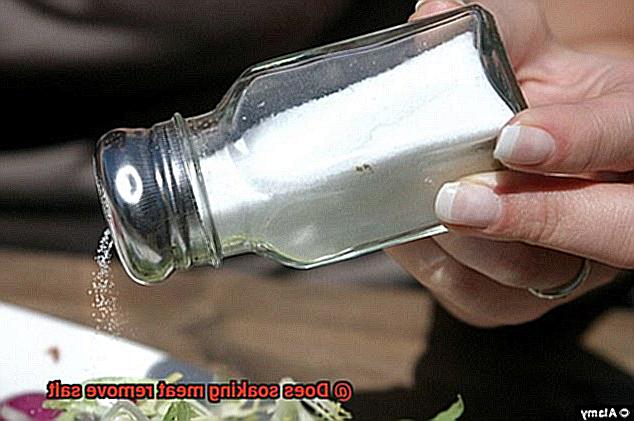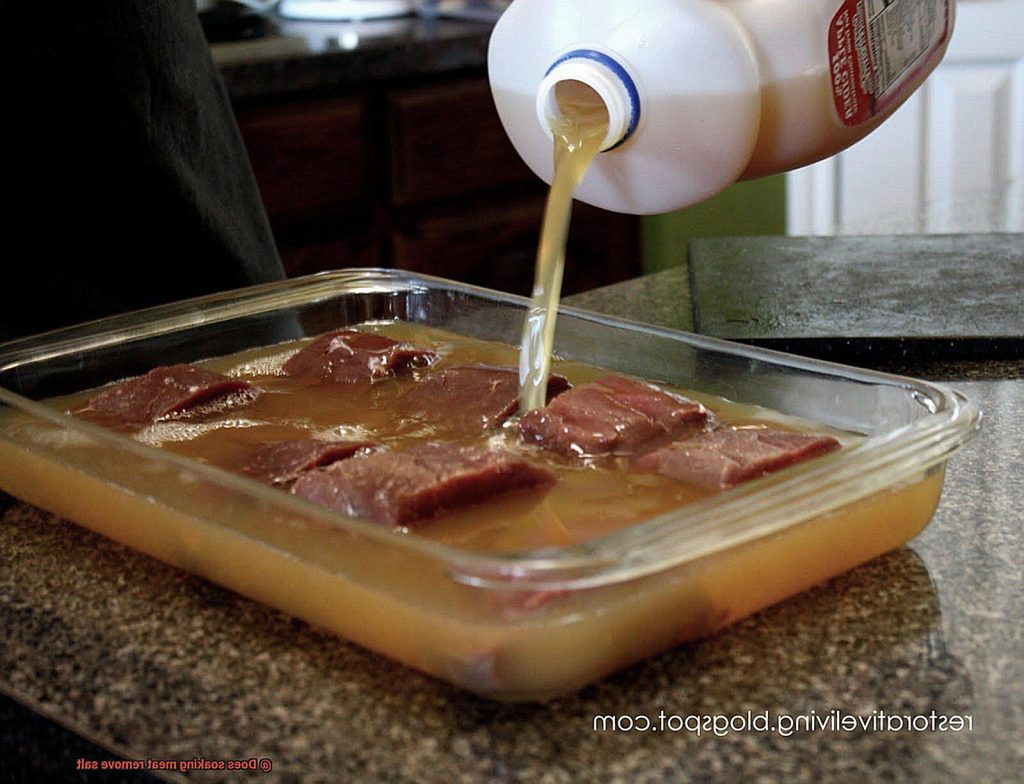Do you know the feeling of ruining your dish by adding too much salt? Or maybe you’re trying to watch your sodium intake and have heard that soaking meat can help remove excess salt. But does it really work?
The answer isn’t cut and dry. Soaking meat in water can certainly reduce the saltiness, but it won’t completely eliminate it. The amount of salt removed depends on factors like the type of meat, how much salt was used, and how long it’s soaked.
Some people worry that soaking meat will cause it to lose flavor and moisture. Others argue that the added moisture helps keep the meat tender and juicy during cooking.
So, what’s the verdict? Does soaking meat remove salt? In this post, we’ll dive into the science behind soaking meat and its impact on reducing salt content. We’ll also explore whether soaking affects texture and taste. Keep reading to find out.
Contents
Overview of Soaking Meat in Water
Soaking meat in water is a common technique that can tenderize and add flavor to your meat. While there are many reasons to soak meat in water, one of the most popular is to reduce the salt content.
When you soak meat in water, the process of osmosis occurs, which allows salt molecules to migrate from the meat into the surrounding water. This leads to a reduction in salt content, with the longer you soak the meat resulting in more salt being removed. However, it’s important to note that soaking meat in water won’t entirely remove all of the salt. Some of it will remain in the meat, already absorbed by muscle fibers and tissues.
If you’re looking to reduce salt content, lean cuts like chicken breast or pork tenderloin benefit more from soaking than fattier cuts like bacon or ham. Additionally, the amount of salt used also impacts the effectiveness of soaking. If you accidentally added too much salt to your marinade or brine, soaking for a few hours may help dilute the salt and reduce overall saltiness. But if the meat has been heavily salted beforehand, soaking may not entirely remove all excess salt.
The duration of soaking is also crucial to achieving desired results. It’s recommended to soak lean cuts for a few hours and up to overnight for tougher cuts. However, over-soaking can lead to loss of moisture and tenderness resulting in dry and tough meat.
While soaking meat in water can be an effective way to reduce salt content and enhance flavor, it’s important to use clean and cold water and not soak for too long. Over-soaking can result in a loss of natural flavor and nutrients.
Factors to Consider When Soaking Meat

When it comes to soaking meat, there are a few key factors to consider in order to achieve the perfect balance of flavor, texture, and reduced salt content. Let’s dive in.
Firstly, the type of meat you’re soaking matters. Different cuts of meat have varying levels of salt content, so it’s important to research beforehand to determine how long your specific cut of meat should be soaked. Some cuts may require longer soaking times or more water changes than others.
Next up is the length of time you soak the meat. Soaking for too long can result in a loss of flavor and texture, while not soaking for long enough may not effectively remove the salt. The sweet spot is between 30 minutes to two hours, depending on the cut of meat.
Now, let’s talk about temperature. Cold water is your best bet as it draws out the salt without cooking the meat. Hot water can cause the meat to cook and toughen, which is not ideal. Keep things cool and refreshing for best results.
Last but not least, changing the water regularly is crucial to removing excess salt and preventing the meat from becoming too salty. Aim to change the water every 30 minutes or so, depending on the size and type of meat being soaked.
Types of Meat to Soak
Soaking your meat can be a great way to reduce saltiness and add flavor. However, not all types of meat require the same soaking treatment. Let’s take a closer look at which meats benefit from soaking and why.
Tough Cuts of Meat
If you’re working with tougher cuts of meat, such as beef brisket or pork shoulder, soaking can help break down the muscle fibers and remove excess salt. These cuts can be quite salty due to their higher fat content and processing methods. Soaking them in water or a flavorful liquid like broth or beer can help make them more tender and delicious.
Lean Cuts of Meat
On the other hand, leaner cuts of meat, like chicken breast or pork tenderloin, do not typically require soaking. These cuts are already relatively low in salt and can easily become over-soaked, resulting in a loss of flavor and texture. If you do choose to soak these meats, do so sparingly and with intention.
Beef and Pork
Beef and pork are two popular meats for grilling but have different salt levels. Pork tends to be saltier due to its higher fat content and may require a longer soaking time to remove excess salt. It’s crucial to do some research beforehand or consult with a professional to determine the appropriate soaking time for each specific type of beef or pork.
Chicken
Chicken is another popular meat for grilling but has a lower salt content compared to beef and pork. As a result, it may not require as long of a soaking time to remove any excess salt. However, if you’re looking to add flavor, marinating chicken in a mixture of herbs, spices, and acidic ingredients before grilling can be an excellent alternative.
Fish
When it comes to seafood, soaking is generally not recommended. Seafood is naturally low in salt, and over-soaking can lead to a loss of flavor and texture. Instead, season seafood lightly before cooking and pair it with flavorful accompaniments like citrus, herbs, or butter.
Amount of Salt Used
Salt is an essential ingredient that can help you achieve those culinary goals. But, have you ever thought about how much salt you’re using in your cooking or marinating? Striking a balance between flavor and sodium intake is crucial to avoid health problems like high blood pressure.
Although a general rule of thumb is to use one teaspoon of salt per pound of meat, this can vary depending on the recipe or personal preference. It’s worth noting that soaking meat in a salty marinade can cause the salt to penetrate deep into the meat, making it difficult to remove excess salt just by rinsing off the surface.
If you’re marinating tougher cuts of meat like beef brisket or pork shoulder, soaking them can help break down muscle fibers and remove excess salt. However, leaner cuts like chicken breast or pork tenderloin do not typically require soaking. If you do choose to soak them, do so sparingly and with intention.
But be careful – even soaking isn’t a foolproof method for removing excess salt. It’s important to be mindful of the amount of salt used in cooking and marinating meat to maintain healthy sodium levels. Consider the type of meat and other ingredients used in your recipes, and experiment with different amounts of salt until you find the perfect balance.
If you’re concerned about excess salt, soaking meat in water for a period of time before cooking may help remove some of it. However, this should be done carefully as it may affect the overall flavor and texture of the meat.
In summary, choosing the right amount of salt is essential for creating delicious and healthy meat dishes. Here are some key takeaways:
- Use about 1 teaspoon of salt per pound of meat as a general guideline.
- Soak tougher cuts of meat to break down muscle fibers and remove excess salt.
- Be mindful of the amount of salt used in cooking and marinating meat to maintain healthy sodium levels.
- Experiment with different amounts of salt to find the perfect balance of flavor.
- Soaking meat in water before cooking may help remove excess salt, but do so carefully to avoid affecting the overall flavor and texture.
Duration of Soaking
The key to achieving the perfect balance lies in knowing the right duration of soaking required for different types of meat.
It’s crucial to note that the amount of time required to soak meat varies depending on the type of meat and its salt content. For instance, beef requires more time to soak compared to pork due to its dense texture and high salt content.
When preparing to soak your meat, using cold water is essential. Warm or hot water may cause the meat to cook slightly, affecting its texture and flavor. The ideal duration for soaking meat ranges from 30 minutes up to 24 hours, depending on the type of meat and desired level of salt removal.
For beef, soaking it for at least 24 hours is recommended if you want to remove a significant amount of salt. During this period, ensure you change the water at least twice to eliminate all excess salt. However, it’s best to avoid over-soaking pork or chicken as it may result in a loss of flavor and tenderness. A soaking time of less than 30 minutes is sufficient for these types of meat.
In summary, duration of soaking is an important factor in removing salt from meat. Here are some key tips to keep in mind when soaking your meat:
- Use cold water
- Know the right amount of time required for different types of meat
- Change the water at least twice during the process
Benefits of Soaking Meat in Water
Look no further than the simple yet effective technique of soaking meat in water. This traditional method has been practiced for centuries and offers numerous benefits that will make your taste buds sing.
Firstly, soaking meat in water reduces its saltiness. When meat is cured or processed, it can become overly salty, resulting in an unpleasant taste. Soaking the meat in water helps to remove some of that excess salt, making it more palatable for you and your guests.
Secondly, soaking meat in water tenderizes it. The water helps to break down the protein fibers in the meat, making it more tender and juicy. This is especially helpful for tougher cuts like beef.
Thirdly, soaking meat in water shortens cooking time. By allowing heat to conduct more efficiently, the meat cooks quicker and more evenly. No more waiting around for hours, wondering if your meal will ever be ready.
To soak your meat properly, simply submerge it in cold water for a period of time, usually 30 minutes to an hour. Remember to change the water at least twice during this process to ensure maximum salt removal. Before cooking as usual, pat the meat dry.
It’s important to note that different types of meat require different soaking times. Beef needs more time than pork due to its dense texture and high salt content. Over-soaking pork or chicken can result in a loss of tenderness and flavor.
Drawbacks of Soaking Meat in Water
While this may seem like a great way to enhance its tenderness and remove excess salt, there are some crucial drawbacks to keep in mind.
Firstly, soaking meat in water can lead to a loss of flavor. As the water dilutes the natural juices and moisture of the meat, it can result in a less appetizing taste. Additionally, if you’re looking to retain all the nutrients from your meat, soaking it in water may not be the best idea as it can cause a loss of essential vitamins and minerals.
Moreover, soaking meat in water can create a breeding ground for bacteria. When meat is soaked in water, it provides an ideal environment for harmful bacteria to grow and multiply. This can lead to serious foodborne illnesses such as salmonella or E. coli if the meat is not cooked thoroughly.
If you’re short on time, soaking your meat in water may not be the best option either. The process takes longer to cook as the water has to be heated up and then evaporated before the meat can start cooking. This can result in overcooked or undercooked meat, which can be both unappetizing and potentially dangerous.
lZReeDr8AqU” >
Conclusion
In summary, soaking meat in water can be a game-changer when it comes to reducing salt content and elevating flavor. However, it’s crucial to keep in mind that this method won’t entirely eliminate all the salt from the meat. The amount of salt removed depends on several factors such as the type of meat, quantity of salt used, and duration of soaking. For instance, lean cuts like chicken breast or pork tenderloin benefit more from soaking than fatty cuts like bacon or ham.
When it comes to soaking meat, there are several essential considerations to bear in mind. These include the type of meat being soaked, how long it’s soaked for, and the temperature and regularity of water changes. Soaking for too long can lead to loss of natural flavor and nutrients while not soaking for long enough may not effectively remove the salt.
While there are undeniable benefits to soaking meat in water such as reducing its saltiness and tenderizing it, there are also drawbacks. Soaking can lead to a loss of flavor and create a breeding ground for bacteria if proper precautions aren’t taken.
To sum up, if you’re looking to reduce sodium intake or add an extra kick of flavor to your meat dishes, then soaking your meat in water can be an effective technique when done with care and attention.






